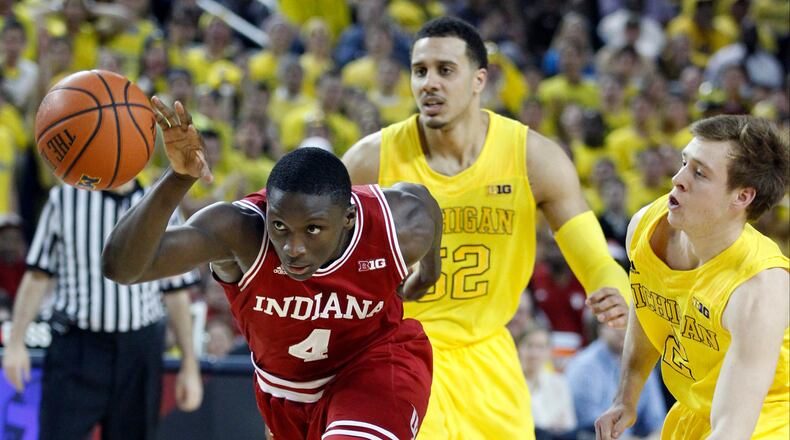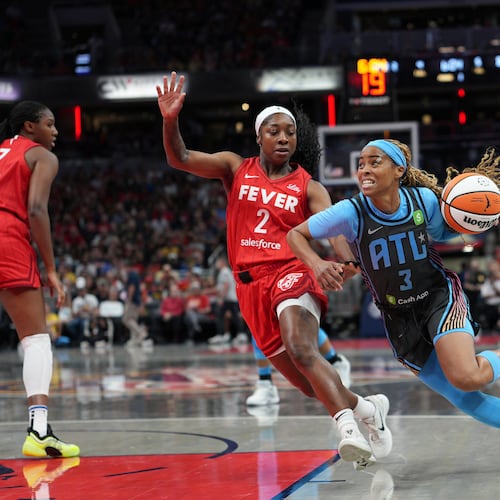Opening tip
It was the fourth-to-last second in his team’s final game of the regular season. Jordan Morgan of Michigan tipped a missed shot by a teammate. The ball, almost perfectly balanced on the rim, rolled about halfway around the cylinder, as if unsure whether it wanted to spin out or nestle into the net.
It is fashionable — and, to some degree, accurate — to moan that the gazillion games before the NCAA tournament mean little. This one meant something.
If Morgan’s follow-up drops through, the Wolverines win by a point and deny Indiana the Big Ten title for the regular season. More important, it might keep the Hoosiers from attaining the No. 1 seed in the Midwest, whose region finals unfold in Indianapolis. (Can you say home-away-from-home?)
The ball, after much deliberation, chose to curl out. Indiana skated 72-71. On an early Sunday evening, 119 days after the season’s first center jump, there came a reminder that a game here and there can matter.
On the poll
The Zags did not zig. Gonzaga stayed the winning course last week and repeated as No. 1 in the Associated Press poll, splitting the first-place vote with next-best Duke (54 and 11).
Louisville injected itself into the debate over No. 1 seeds, rising four steps to fourth, behind Indiana.
The institutions from the Beaver State headed in opposite directions. Oregon State leapt from 14th to 10th, matching the ‘Ville for the most upward mobility, while Oregon went from No. 19 to ARV — also receiving votes.
Final Four-cast
Duke. With Ryan Kelly in the rehab room, a No. 1 seed seemed pie-in-the-sky for the Blue Devils. Now? Give each Dookie a large slice. With scorers galore, perhaps the team to beat.
Indiana. Granted, the Hoosiers nearly closed the regular season on a 1-3 slide. Yet no team has a 1-2 punch approaching Cody Zeller and Victor Olapido. Uptight coach Tom Crean does need to chill, though.
Louisville. The essentials are in place — shadow-casting big man (Gorgui Dieng), dynamic point guard (Peyton Siva), crafty coach (no ID necessary) and an asphyxiating defense.
Miami. Though they staggered to the finish line, the Hurricanes' maturity (average age of the regulars is 22 1/2), size and cheetah-quick point guard Shane Larkin puts them in play.
Conference call
Expect a “Big” day on Selection Sunday, meaning that the Big East and Big Ten will combine for the largest collection of teams to the NCAAs.
The Big East, in its valedictory, is projected to land eight bids, one more than the Big Ten. The similarly named Big 12 anticipates five, same as the ACC, Atlantic 10, Pac-12 and Mountain West.
The SEC? Only three. On the bright side, spring football practices are in full swing.
Mid-major update
The consensus among bracket projections holds that mid-major conferences will contribute 10 at-large teams to the tournament. Not bad, especially when the highest ranked middie after Gonzaga is No. 15 New Mexico.
(True, the Zags and Lobos might no longer fit the category, which has been subdivided into the paradoxical “high mid-majors.” The arbitrary definition in this context: hailing from a non-BCS league in football).
After New Mexico, the mid-majors appear in bunches: Saint Louis (16th), Memphis (20th), Creighton (23rd) and Virginia Commonwealth (25th), along with the poll’s two highest also-rans, St. Mary’s and Butler.
In a season devoid of fautless teams, the mids might get enough bids to claim dibs on a Final Four crib.
Profilin’
Make room for another fab freshman in the file labeled, “We (in college basketball) hardly knew ye.”
UCLA coach Ben Howland spoke truthfully on Senior Day when he said that rookie guard Shabazz Muhammad was NBA-bound after the season.
Who could blame Muhammad? Tied for 41st in Division I with an 18.3-point scoring average, he appears pro-ready and eager to escape the scrutiny that comes with doing business in Los Angeles. Since a three-game suspension for receiving improper benefits during his recruitment, Muhammad has been forced to explain the source of his Gucci backpack and his unwillingness to join in a player dogpile after a dramatic win.
Son of a gun
Traveon Jackson likely never will rise to the hoops heights reached by his father, Jimmy. For one game, though, the Wisconsin guard resembled Dad in his heyday with a buzzer-beating 3-pointer to break a tie with Penn State.
Jackson’s 15 points Sunday represented a season high. When Jimmy made magic for Ohio State, that total would have implied an off day. The elder Jackson twice was selected All-American and later took a career-long tour of the NBA, playing for 12 teams.
Traveon, four inches shorter at 6-foot-2, says he has shed the burden of being Jimmy’s son. Sunday’s heroics helped forge his own identity, as all sons of guns deserve.
Final Four-stalled
Biggest Final Four upsets, No. 1: And the winner is … Villanova over Georgetown 66-64 in the 1985 title game on April Fool’s Night. The Hoyas were ranked No. 1 with two losses. The Wildcats were designated a deserving eighth seed, with 10 losses — two to Georgetown. ‘Nova’s first three tournament wins were by an aggregate seven points, but they left plenty of luck in reserve. The Wildcats shot 79 percent from the floor against a defense anchored by Patrick Ewing. No foolin’.
Stat stuffer
Cody Zeller of Indiana accumulated 25 points and 10 rebounds — but also six turnovers — in the aforementioned win over Michigan.
At the buzzer
The most captivating television of every season involves no ball, no uniformed players, no refs and no crowd.
The tournament selection show, carried by CBS since seemingly before the remote control was invented, is so spot-on in its simplicity that the network has adhered to the same format: Reveal each quadrant of the bracket, allowing hoop-heads at home to fill out their copies, followed by talking heads offering instant, brief analysis.
Tweaks such as look-ins at teams’ gatherings as their invitations to the dance are confirmed — hugs! high-fives! — have been minimal. If anything has changed, it is with viewers, many of whom now complete their personal brackets with a tapping of laptop keys rather than a scratching of pens.
Hard to explain why an hour of inaction is as highly anticipated, if not more, as the 67 two-hour games to follow. This comparable scenario might explain it: For many, the highlight of enjoying a delicious meal happens the moment it is served.
About the Author
Keep Reading
The Latest
Featured


